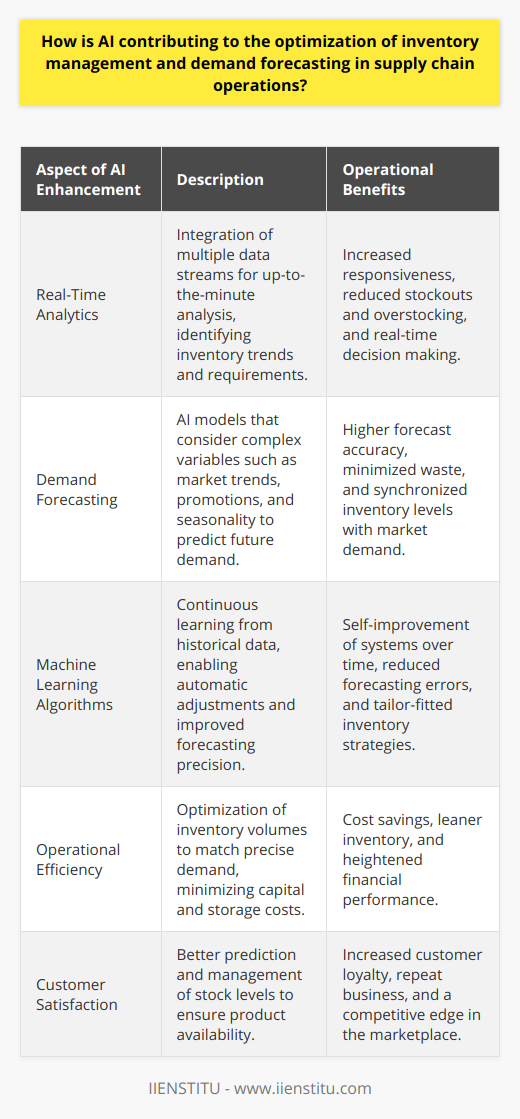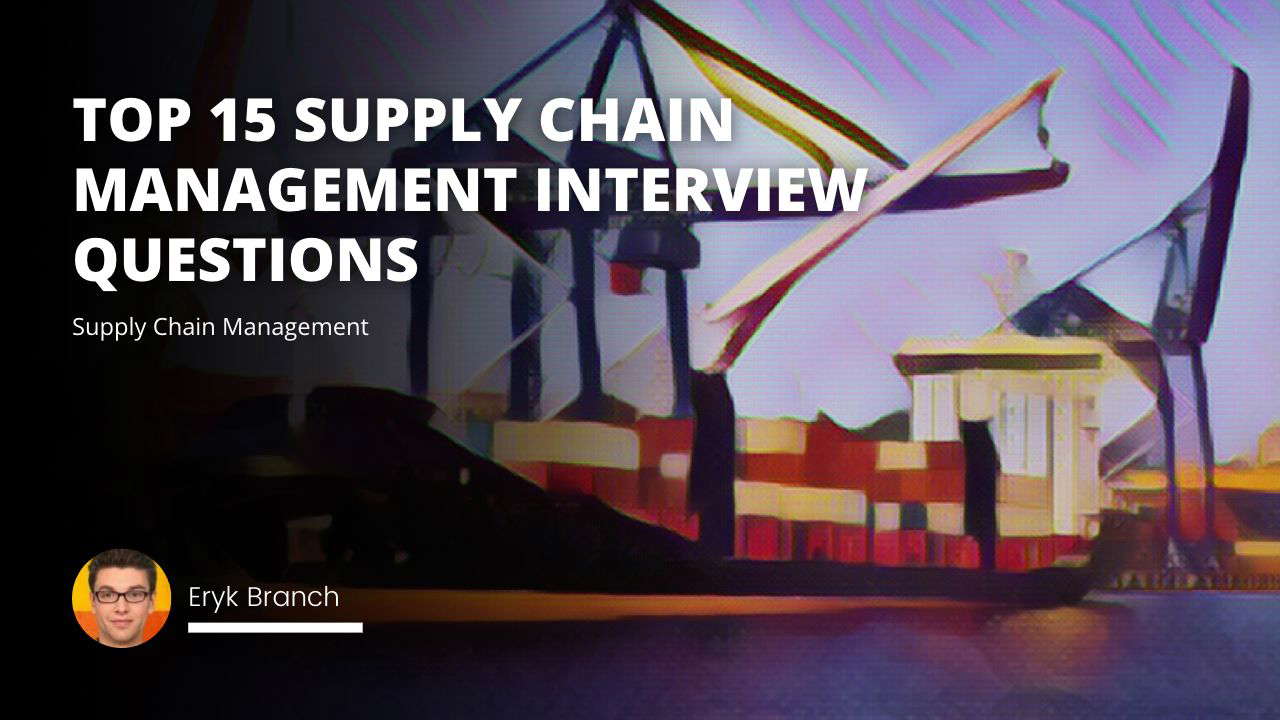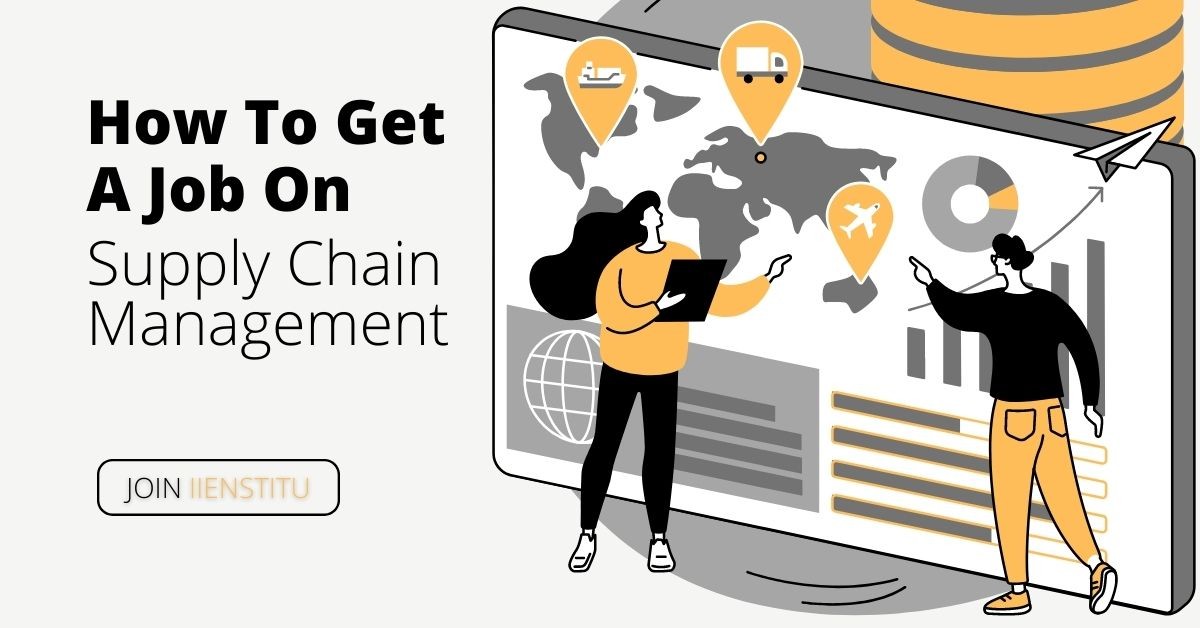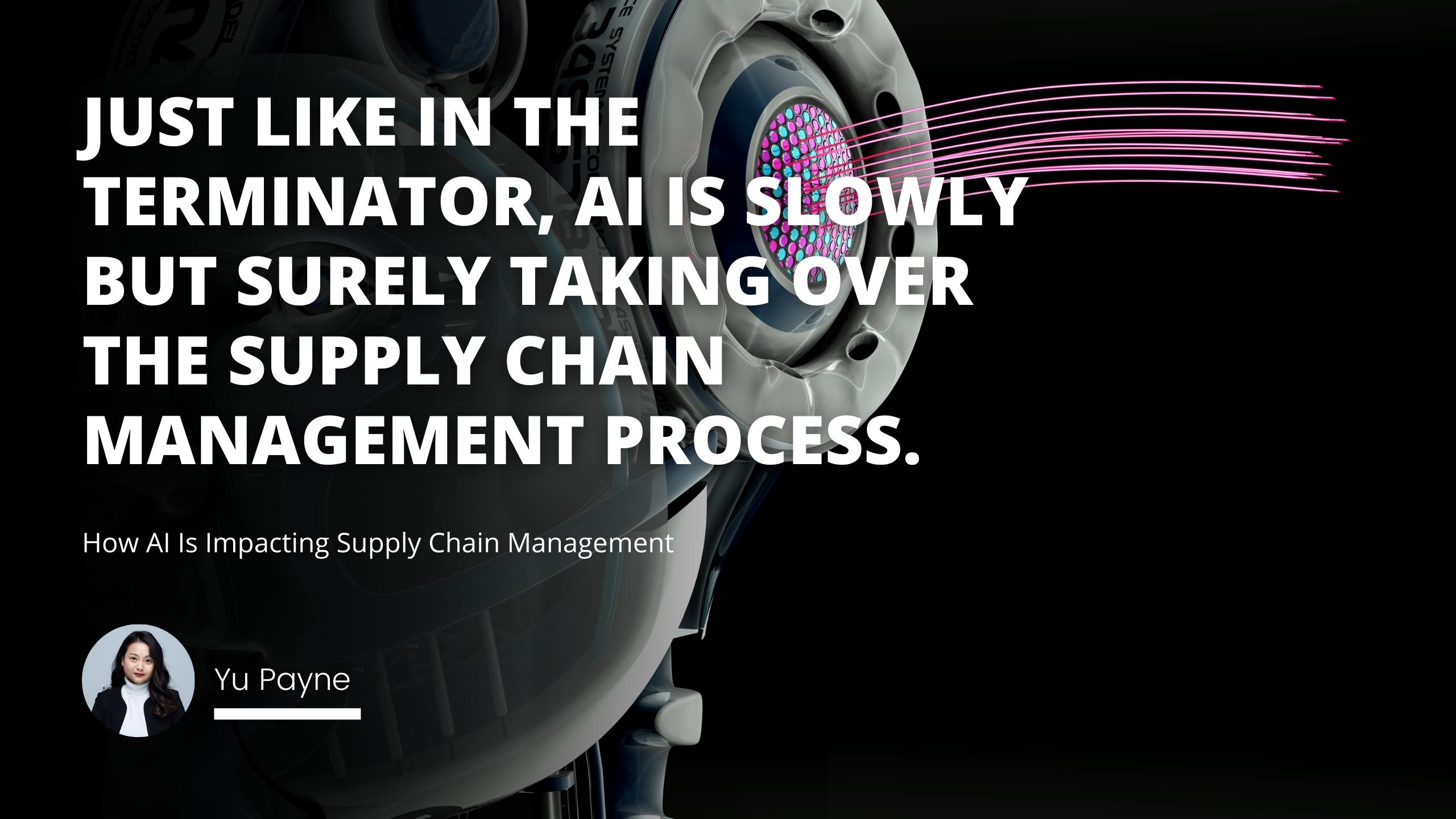
The term “supply chain management” (SCM) was first coined in the early 1980s. Since then, SCM has become an integral part of many large and small businesses. The primary goal of SCM is to ensure that goods and services are delivered to customers promptly and efficiently. To achieve this goal, SCM must consider various factors, including the flow of raw materials, finished products, and information.
In recent years, the advent of artificial intelligence (AI) has significantly impacted SCM. AI-powered solutions can help businesses automate various tasks related to SCM, such as demand planning, inventory management, and product development. In addition, AI can also be used to improve the effectiveness of supply chain partners.
The question is: are supply chain companies embracing technology?
First, look at which technologies are used in supply chain management. For example, in a 2021 survey, 40 percent of supply chain industry professionals had already integrated cloud computing and storage technologies into company operations. In addition, inventory and network optimization tools have the highest rate on the adoption list of supply chain companies in the next five years.
In recent years, there has been a significant amount of investment in new technologies that have the potential to revolutionize supply chain management. These are some technologies that can help businesses. These include cloud computing and storage, sensors and automatic identification, inventory and network optimization tools, robotics and automation, predictive and prescriptive analytics, industrial internet-of-things (IoT), 3D printing, wearable, and mobile technology, autonomous vehicles and drones, artificial intelligence technologies.
While it is still early days for many of these technologies, they have the potential to dramatically improve the efficiency of supply chains and enable companies to respond better to changes in demand. Therefore, supply chain managers should be aware of these emerging technologies and how they might be applied in their operations.
A recent study by DHL found that AI is becoming more popular in the world of SCM. The study found that 50 percent of surveyed companies are already using AI in their SCM processes, and another 30 percent are planning to do so shortly.
Not surprisingly, the benefits of AI are a significant factor driving this trend. According to the DHL study, companies that are using AI in their SCM processes report substantial improvements in efficiency (46 percent), accuracy (39 percent), and cost savings (34 percent).
A recent study by DHL found that AI is becoming more popular in the world of SCM. The study found that 50 percent of surveyed companies are already using AI in their SCM processes, and another 30 percent are planning to do so shortly.
How To Measure Supply Chain Processes Using Quantitative And Qualitative Metrics
Balancing Capacity Responsiveness Flexibility And Cost İn Supply Chain
Not surprisingly, the benefits of AI are a significant factor driving this trend. According to the DHL study, companies that are using AI in their SCM processes report substantial improvements in efficiency (46 percent), accuracy (39 percent), and cost savings (34 percent).
AI is having a positive impact on SCM. As technology evolves, we can expect even more innovations in this field.
Only time will tell how AI will impact SCM in the coming years, but one thing is for sure: the future of SCM is looking very bright.
What is AI, and how does it work in supply chain management?
AI is a branch of computer science that deals with creating intelligent machines that can work and react like humans. AI-powered solutions use various techniques, including machine learning, natural language processing, and computer vision.
In the context of SCM, AI can automate various tasks, such as demand planning, inventory management, and product development. In addition, AI can also be used to improve the effectiveness of supply chain partners.
How has AI changed the way businesses operate and manage their supply chains?
AI has had a profound impact on the way businesses operate. In the past, most business decisions were made based on historical data and gut feelings. But with AI, companies can now make better decisions by analyzing large amounts of data in real-time.
This newfound ability to make more informed decisions has led to several changes in how businesses operate. For example, many companies are now using AI to improve customer service and develop new products and services.
What does the future hold for AI in SCM?
The future of AI in SCM is very bright. As technology evolves, we can expect even more innovations in this field. In particular, we can expect AI-powered solutions to become more widespread and affordable.
In the future, AI will likely play an even more significant role in SCM. So if you’re not already using AI in your SCM process, now is the time to start investigating how you can incorporate this transformative technology into your operations.
The benefits of using AI in supply chain management are clear. But what about the risks?
Like any new technology, AI comes with its fair share of risks. For example, if not used properly, AI can lead to sub-optimal decision-making. In addition, AI-powered solutions can be expensive and require a certain level of technical expertise to implement and maintain.
Despite these risks, the potential benefits of AI in SCM are too great to ignore. So if you’re looking for a way to improve your supply chain management process, consider incorporating AI into your operations.
Challenges businesses face when implementing AI into their supply chains.
The challenges businesses face when implementing AI into their supply chains are:
1. Ensuring the data is of good quality: For AI to work correctly, it relies on high-quality data. Therefore, one of the challenges businesses face when implementing AI is ensuring that the data they use is accurate and up-to-date.
2. Identifying the proper use cases: Another challenge businesses face when implementing AI is identifying the appropriate use cases. Not every problem can be solved with AI, so it’s essential to consider whether AI is the best solution for a particular situation.
3. Implementing and maintaining AI solutions: Implementing and maintaining AI solutions can be complex and expensive. Therefore, it’s essential to carefully consider whether or not AI is the right solution for a particular problem before investing in the technology.
Despite these challenges, AI can still be a valuable tool for businesses looking to improve their supply chain management process. So if you’re considering implementing AI into your operations, keep these challenges in mind.
AI can be a powerful tool for businesses to improve their supply chain management process when used correctly. However, some challenges enterprises face when implementing AI into their supply chains. These challenges include ensuring the data is of good quality, identifying the proper use cases, and implementing and maintaining AI solutions.
Despite these challenges, the potential benefits of AI in SCM are too great to ignore. So if you’re looking for a way to improve your supply chain management process, consider incorporating AI into your operations.
Future trends for AI in supply chain management
Increasing use of predictive analytics: As AI technology continues to evolve, we can expect to see increasing use of predictive analytics in SCM. Predictive analytics is a type of AI that analyzes data to predict future events. This information can be used to improve decision-making in the supply chain.
More widespread use of robotics: Robotics is another area where we can expect continued growth in AI use in SCM. Robotics can be used for tasks such as picking and packing orders and more complex tasks such as loading and unloading trucks.
Greater integration of AI into ERP systems: As AI technology becomes more advanced, we can expect to see greater integration of AI into enterprise resource planning (ERP) systems. AI can automate tasks such as order processing and invoicing, which can help improve efficiency in the supply chain.
Use of blockchain technology: Blockchain is a type of distributed ledger technology that can track and manage supply chain transactions. We can expect more effective use of blockchain in SCM as businesses look for ways to improve transparency and traceability in their supply chains.
Continued growth of the sharing economy: The sharing economy is another trend likely to impact SCM in the future. In the sharing economy, businesses share resources instead of owning them outright. This model can be applied to SCM, for example, by sharing transportation resources such as trucks and warehouses.
The future of AI in SCM is looking bright. We expect continued growth in using AI-powered predictive analytics, robotics, and blockchain technology. This growth will be driven by businesses looking for ways to improve efficiency and transparency in their supply chains. So if you’re looking to stay ahead of the curve, keep an eye on these emerging trends.
There are many different ways in which AI is impacting SCM. Here are just a few examples:
1. Automation of tasks: One of the most critical ways AI impacts SCM is through the automation of various tasks. For example, businesses can now use AI-powered software to generate demand forecasts automatically. This can help companies save a significant amount of time and money that would otherwise be spent on manual forecasting.
2. Improved accuracy: Another benefit of using AI in SCM is that it can help improve the accuracy of various tasks. For instance, by using machine learning algorithms, businesses can more accurately predict customer demand. This can help companies avoid stockouts and other problems that disrupt the flow of goods.
3. Enhanced decision-making: AI can also enhance decision-making in SCM. For example, by analyzing large amounts of data, AI-powered software can help businesses identify trends and patterns that would otherwise be difficult to spot. This information can then be used to make better production planning and pricing decisions.
While some challenges businesses face when implementing AI into their supply chains, the benefits of doing so are clear. With the continued advancement of AI technology, we will likely see even more amazing things happening in the world of supply chain management. If you are interested in learning more about how to implement AI into your own business’s supply chain, join us for our upcoming Supply Chain Management course.
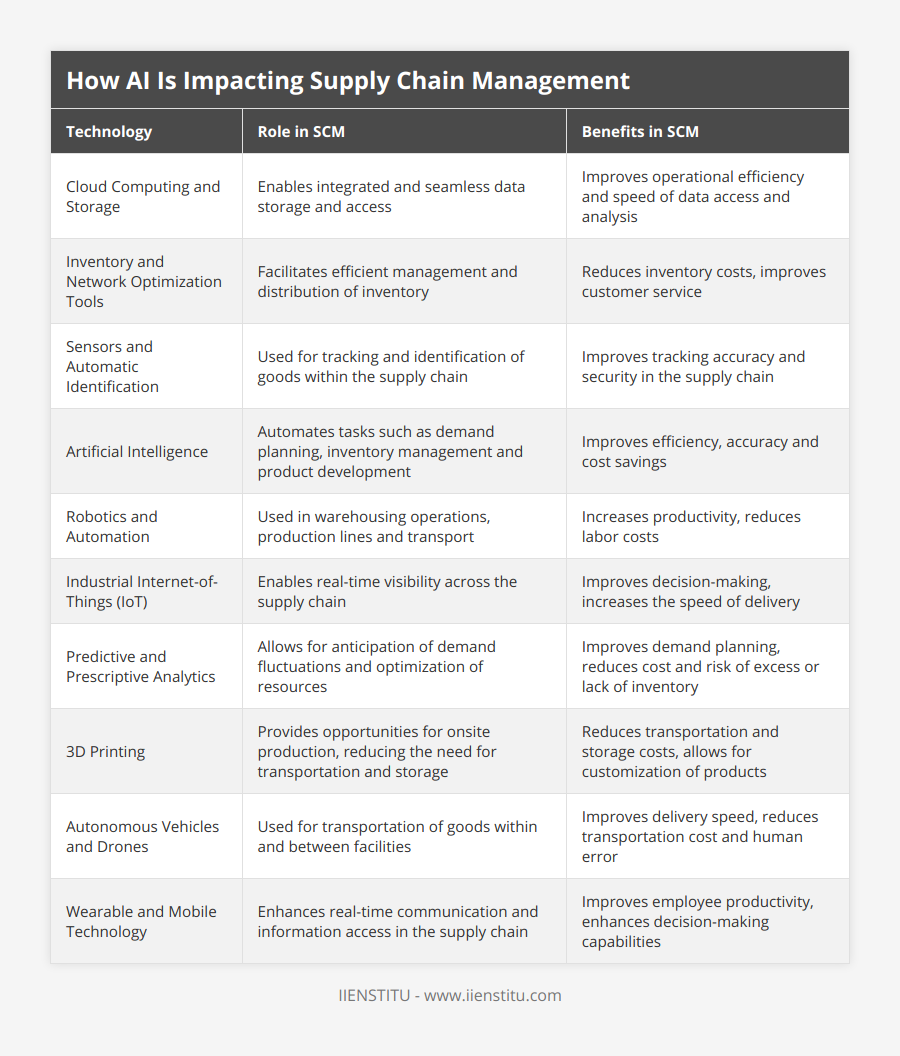
Frequently Asked Questions
What is your understanding of AI and its impact on supply chain management?
AI is quickly becoming a integral part of supply chain management for a number of reasons. For example, AI can help to streamline processes, optimize resources, and predict demand. Additionally, AI can help to identify issues in the supply chain and propose solutions. As the world becomes more connected, AI will only become more essential for managing the flow of goods and services. Ultimately, AI has the potential to revolutionize supply chain management and create a more efficient and effective system.
How do you see AI transforming the procurement process?
The potential for AI to transform the procurement process is significant. For example, AI can be used to automate the sourcing and supplier selection process. This can help procurement teams to identify the best supplier for a given product or service, based on criteria such as cost, quality, and delivery time. In addition, AI can be used to monitor supplier performance and automatically flag any issues that need to be addressed. This real-time visibility into supplier performance can help procurement teams to avoid disruptions and ensure that products and services are delivered on time and to the highest standards. Ultimately, AI has the potential to transform the procurement process from a reactive one to a proactive one, ensuring that businesses always have access to the best possible suppliers.
How is AI affecting supply chain management?
Impact on Forecasting and Demand Planning
Artificial Intelligence (AI) is transforming supply chain management by enhancing forecasting and demand planning capabilities. AI-based algorithms analyze historical data and external factors to create accurate demand predictions, enabling companies to optimize inventory levels and reduce costs.
Automation of Routine Tasks
AI-powered software automates routine tasks, such as order processing and warehouse management, allowing supply chain professionals to focus on strategic decision-making. This efficiency improvement ultimately leads to more timely deliveries and enhanced customer satisfaction.
Enhanced Decision-Making Capabilities
AI tools can provide real-time insights and recommendations for supply chain managers, allowing them to make better decisions in areas such as procurement, transportation, and distribution. This information helps managers to identify potential problems, enabling them to implement effective solutions quickly and proactively manage supply chain risks.
Improved Collaboration with Suppliers
AI-driven platforms facilitate communication and collaboration between organizations and their suppliers, allowing for more efficient coordination of activities. By sharing real-time data on inventory levels and demand forecasts, organizations can work more effectively with their suppliers to ensure timely fulfillment of orders.
Increased Supply Chain Resilience
AI enables organizations to build more resilient supply chains by identifying potential disruptions and suggesting potential mitigation strategies. This proactive approach to risk management helps organizations better prepare for and respond to unforeseen events, reducing their overall vulnerability.
In summary, AI is playing a pivotal role in revolutionizing supply chain management by improving forecasting, automating routine tasks, enhancing decision-making capabilities, fostering collaboration, and increasing supply chain resilience. As AI technology continues to advance, it is anticipated that its impact on supply chain management will become even more profound, resulting in significant operational and strategic advantages for organizations that incorporate AI-driven processes into their supply chain practices.
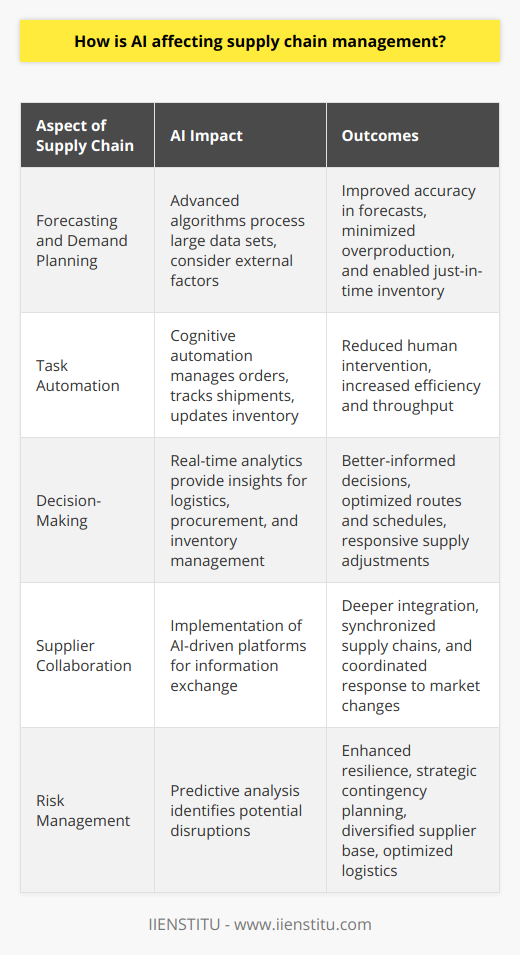
What is the future of AI in supply chain management?
The Role of AI in Supply Chain Optimization
The future of artificial intelligence (AI) in supply chain management (SCM) entails the potential for significant improvements in efficiency, cost reduction, and decision-making processes. These innovations will be driven by the continuous development of machine learning algorithms, advanced analytics, and automation technologies. As SCM evolves, AI can facilitate numerous aspects of the process, including demand forecasting, inventory management, and transportation logistics.
Demand Forecasting
Implementing AI in SCM can dramatically enhance demand forecasting accuracy by analyzing complex data sets and identifying patterns. AI systems can utilize historical sales data, customer behavior analytics, and external factors such as weather, market trends, and economic indicators to predict future demand more accurately. This leads to better planning and resource utilization, ultimately improving the responsiveness of the supply chain to market dynamics.
Inventory Management
Inventory management is another area where AI can deliver significant benefits by automating and streamlining stock control. AI-driven tools can monitor stock levels, identify patterns of consumption, and optimize product replenishment schedules. Additionally, AI can help in managing supplier relationships, ensuring prompt deliveries and minimizing stockouts. This synchronized approach to inventory management translates into reduced holding costs, minimized stock obsolescence, and improved customer satisfaction.
Transportation Logistics
AI is set to revolutionize transportation logistics by optimizing route planning and enabling efficient load management. Machine learning algorithms can analyze vast amounts of data from multiple sources, such as traffic patterns, vehicle maintenance records, and driver preferences, to provide real-time route recommendations. This leads to reduced fuel consumption, on-time deliveries, and optimized fleet management.
Risk Management and Decision-Making
Incorporating AI into the SCM process enhances risk management and decision-making capabilities by providing actionable insights and robust predictive models. AI can help organizations monitor a wide range of variables – from geopolitical events to supplier disruptions – and assess their potential impact on supply chain performance. Armed with this information, supply chain professionals can proactively mitigate risks and make data-driven decisions that align with organizational objectives.
Conclusion
The future of AI in supply chain management promises a landscape marked by heightened efficiency, cost-effectiveness, and strategic decision-making. Through applications in demand forecasting, inventory management, transportation logistics, and risk management, AI has the potential to significantly enhance all aspects of the SCM process. By embracing and investing in AI technologies, organizations can ensure their supply chains are agile, resilient, and well-equipped to respond to ever-changing market conditions.
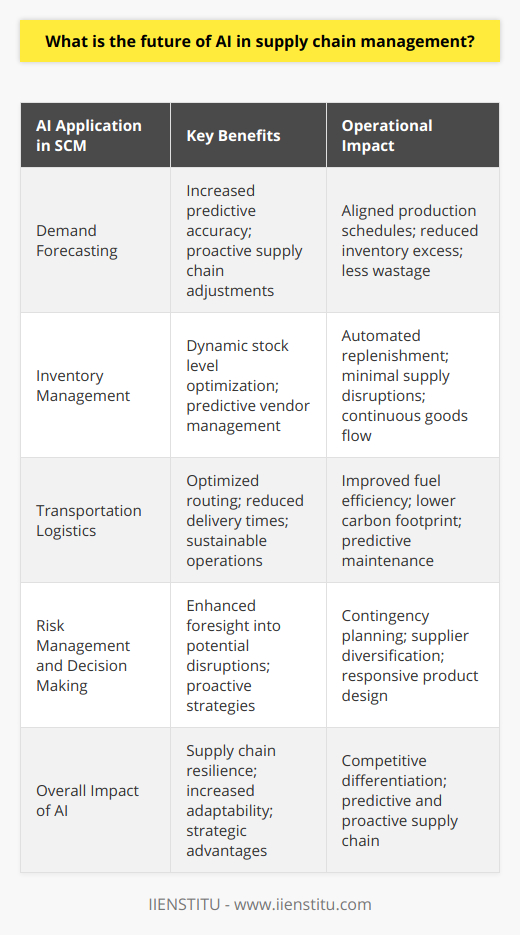
How AI is spreading throughout the supply chain?
AI Applications in the Supply Chain
The rapid progression of artificial intelligence (AI) technology is transforming supply chain management (SCM) by offering intelligent solutions to optimize operations. AI has integrated across various supply chain activities, thereby enabling organizations to become more agile, efficient, and effective.
Demand Forecasting and Inventory Management
AI is revolutionizing the way demand forecasting and inventory management is conducted. By leveraging machine learning algorithms, AI can analyze large volumes of historical and real-time data, such as seasonal trends, weather patterns, and economic indicators, to generate accurate demand forecasts. Consequently, companies can make well-informed decisions regarding inventory levels, leading to reduced stockouts, overstocking, and waste, which subsequently minimizes costs and maximizes profits.
Warehouse Automation
In the warehousing domain, AI is facilitating automation by implementing advanced robotics and intelligent control systems. These autonomous solutions can automate tasks like sorting, picking, packing, and storage, thus increasing process efficiency and reducing human errors. Additionally, AI-driven warehouse management systems can intelligently allocate resources and streamline workflows, leading to optimal space utilization and enhanced operational productivity.
Transportation and Route Optimization
AI has a significant impact on transportation and logistics as well. It enables the development of sophisticated route optimization algorithms that consider factors like traffic patterns, fuel costs, and delivery requirements to suggest the most efficient and cost-effective routes for shipments. Integrating AI with Internet of Things (IoT) technologies can improve asset tracking and enable predictive maintenance, ensuring minimal downtime and reduced transportation costs.
Supplier Relationship Management
Finally, AI plays a crucial role in improving supplier relationship management. By processing vast amounts of procurement-related data, AI can identify patterns in supplier performance and compliance, assess potential risks, and offer actionable insights for managing supplier collaborations. This enables organizations to establish more effective partnerships, negotiate better supplier contracts, and mitigate risks throughout the supply chain.
In conclusion, the proliferation of AI technology across the supply chain has provided companies with numerous tools and opportunities to enhance their SCM processes. By adopting AI-driven solutions, businesses can ensure better demand forecasting, improve warehouse operations, optimize transportation, and strengthen supplier relationships, thus achieving increased efficiency, profitability, and competitiveness in a dynamic global market.
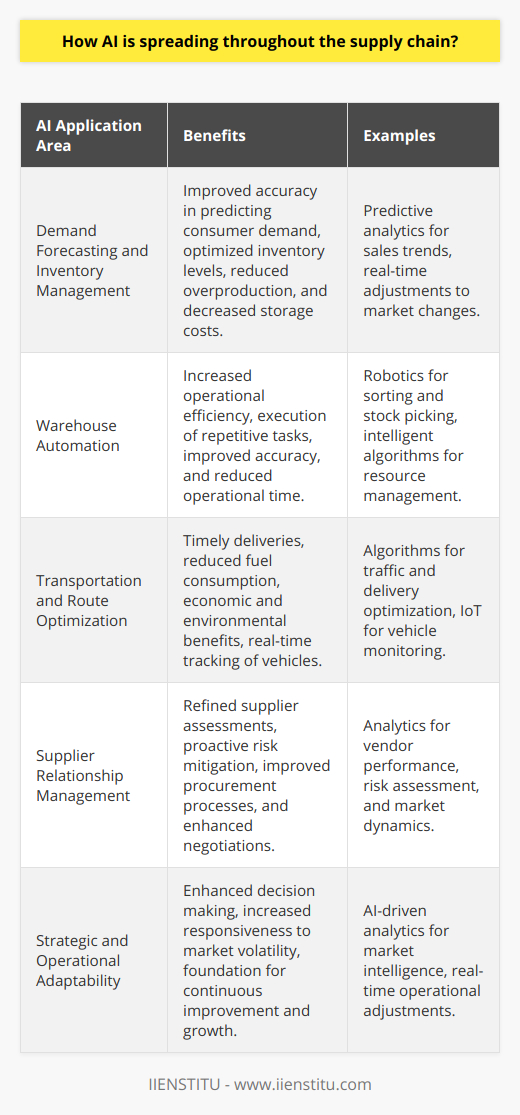
How is AI and machine learning changing the way we manage the supply chain?
Impact on Demand Forecasting
AI and machine learning are radically transforming demand forecasting by leveraging voluminous data and enabling accurate predictions. They allow the assessment of factors such as seasonal trends, weather patterns, and socio-economic data that impact customer needs. Through sophisticated algorithms, AI can analyze historical data and produce detailed forecasts for future demand.
Increased Inventory Efficiency
The implementation of AI in inventory management allows for efficient utilization of warehouse space and optimization of stock levels. Machine learning algorithms continually analyze incoming and outgoing products – identifying the best restocking days, minimizing inventory holding costs, and reducing order lead times. With dynamic pricing strategies based on real-time data, AI can significantly enhance inventory turnover ratios and facilitate just-in-time deliveries.
Enhanced Procurement Processes
AI-powered decision-making tools support risk assessment, supplier evaluation, and pricing negotiations. By tapping into vast amounts of data, machine learning can identify trends and patterns that may lead to supply chain disruptions. AI-driven chatbots and virtual assistants aid supplier communication, automating purchase orders and invoices. This contributes to shortened order-to-delivery cycles and proactive management of supplier relationships.
Predictive Maintenance of Equipment
In the manufacturing realm, AI-based predictive maintenance models monitor the health of machines and equipment, reducing the likelihood of unplanned downtime. Utilizing advanced sensors and historical performance data, AI detects signs of machine degradation and indicates the need for maintenance or replacement. Consequently, maintenance resources are allocated effectively – minimizing the impact on production schedules and overall supply chain efficiency.
Effective Quality Control
AI-driven quality control systems ensure standardization and consistency across the supply chain. Computer vision and machine learning can automatically analyze product images to identify defects and deviations from quality standards. With near real-time feedback, adjustments can be made in the production process – effectively rectifying issues and maintaining product quality.
In summary, AI and machine learning are revolutionizing the way we manage supply chains by offering innovative solutions for demand forecasting, inventory management, procurement, predictive maintenance, and quality control. Embracing these advanced technologies positions companies for improved efficiency, reduced lead times, and effective risk management – ultimately enhancing customer satisfaction and increasing competitiveness in the global market.
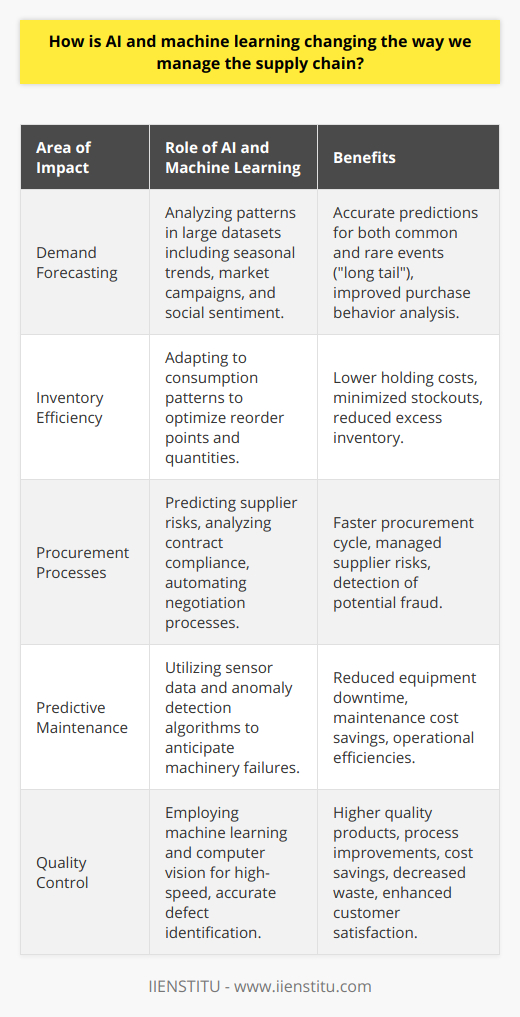
What is the impact of Artificial Intelligence on logistics and supply chain management?
Impact of AI on Logistics Efficiency
Artificial intelligence (AI) significantly impacts logistics and supply chain management by streamlining operations and optimizing decision-making processes. The use of AI and machine learning algorithms enables identification of patterns and trends, which allows companies to predict demand, optimize inventory management, and forecast order volumes with greater accuracy.
Automation of Routine Tasks
AI-powered robots and autonomous vehicles are revolutionizing warehouse management and transportation of goods. They take over repetitive and manual tasks such as picking, packing, and sorting, which results in increased productivity, reduced human error, and greater cost-saving measures. In addition, driverless trucks and drones provide safer and more efficient means of transporting goods, minimizing delays and reducing the overall carbon footprint.
Optimization of Routes and Delivery Timings
Through real-time data analysis, AI-enhanced systems can compute optimal routes for the transport of goods, substantially reducing fuel consumption and delivery times. AI algorithms also forecast accurate delivery timetables, which not only improve customer satisfaction but also enable better resource allocation and utilization within businesses.
Enhanced Customer Service and Risk Management
AI-driven chatbots and virtual assistants provide prompt and efficient customer service throughout the supply chain, from order placements to post-delivery support. By anticipating and addressing customer concerns proactively, businesses can maintain and enhance their reputation. Furthermore, AI systems enhance risk management by analyzing vast amounts of data to identify potential threats, such as financial risks or geographical disruptions, ensuring business continuity and supply chain resilience.
Sustainability and Waste Reduction
AI's predictive capabilities support eco-friendly supply chain practices by minimizing waste through improved inventory management, reducing over-stocking or under-stocking situations. Intelligent algorithms can also recommend alternative suppliers or materials, contributing to streamlined and eco-conscious decision-making.
In conclusion, the integration of artificial intelligence in logistics and supply chain management offers a plethora of benefits, including operational efficiency, cost savings, enhanced customer satisfaction, and environmental sustainability. Moreover, AI enables companies to proactively mitigate risks, ensure business continuity, and adapt to the rapidly changing market dynamics.
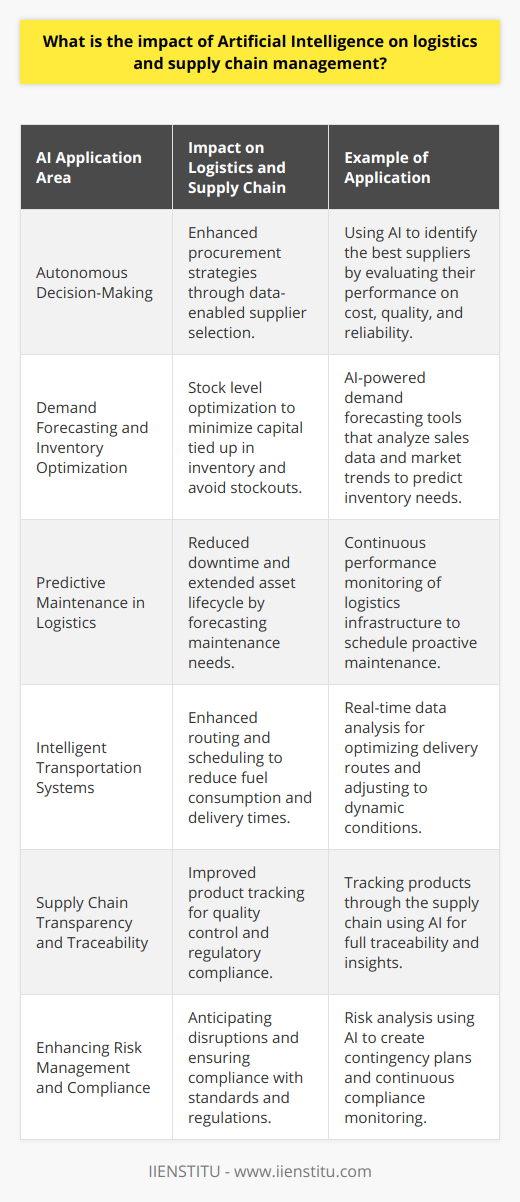
How is AI contributing to the optimization of inventory management and demand forecasting in supply chain operations?
AI's Role in Inventory Management
Artificial Intelligence (AI) is revolutionizing the way supply chains manage inventory and predict consumer demand. Algorithms used in AI enable companies to analyze vast amounts of data in real-time, leading to accurate predictions about future demand. This assists in optimizing inventory levels, reducing stockouts, and minimizing excess stock.
Real-Time Analytics and Inventory Optimization
One essential element of AI in inventory management is the use of real-time data. AI-powered platforms can automatically gather and process data from multiple sources, such as sales statistics, in-store data, and historical trends. This helps businesses understand their inventory performance better and enables them to make well-informed decisions on stock replenishment and management.
Demand Forecasting and Inventory Management
Through AI-based demand forecasting, supply chains can predict market trends more accurately and understand customer behavior better. Machine learning algorithms analyze historical demand patterns, socio-economic factors, and seasonal fluctuations to generate demand forecasts. This information aids companies in making data-driven decisions, leading to improved inventory management and reducing the likelihood of overstocking or stock shortages.
Embracing Machine Learning
Another critical area where AI contributes to inventory management optimization is through Machine Learning (ML). ML enables supply chain systems to learn from their previous successes and failures, and fine-tune their decision-making processes for better inventory management. For instance, ML algorithms can learn from the success of specific forecasting models and adjust inventory management strategies accordingly.
Impact on Overall Efficiency
By embracing AI-powered solutions for inventory management and demand forecasting, supply chain operations can become more efficient. Companies can reduce holding costs associated with excess inventory, minimize lost sales due to stockouts, and improve customer satisfaction by ensuring products are available when needed. AI-driven inventory management tools contribute to the long-term success of supply chain operations by enabling companies to better manage their resources and adapt quickly to changing consumer demands.
In conclusion, AI is playing a significant role in enhancing inventory management and demand forecasting in supply chain operations. Through real-time analytics, machine learning, and accurate demand predictions, businesses can optimize their inventory levels, reduce stock-related costs, and improve overall efficiency. As AI-driven technologies continue to advance, so too will their impact on the future of supply chain management.
